Fiat tagged their new V-8 the "Otto Vu" because they assumed that the Ford Motor Company had a trademark on V-8. They didn't, but it was a nod towards the all-powerful American car industry, who had been mass producing V-8s since 1932 and was on the verge of creating a wide variety of OHV V8s across the field of manufacturers.
Europe lagged behind in V8 technology until the mid 1960s. The French had nothing, straddled by a heavy tax burden on large engines, Great Britain conjured up little until the Daimler V8 in the early 60s, and even in Germany, Mercedes Benz stuck with straight eights and sixes until the 70s. BMW's V8 of the mid 50s showed promise and powered their luxury cars, but the firm soon reverted to a series of fours and straight sixes.
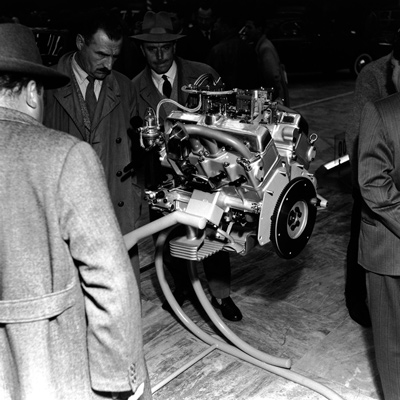
The new V8 Fiat engine as seen at the Torino Auto Show in 1952. Note the unusual placement of the exhuast headers. Photo by Silvio Durante, copyright Publifoto Torino/La Presse.
|
The reasons for this dearth of V8s had nothing to do with lack of technology or talented designers, but simply that in a post war environment, major manufacturers looked toward building small, gas efficient cars for the mass market. V8s were heavy, and although compact, were often too wide to fit into narrow chassis.
And then, like now, V8s tended to consume great quantities of fuel.
Still, there were large and luxury cars to be built and sold. Which is how the now legendary Fiat Otto Vu came to being in the first place. And thusly begins the fascinating drama of the birth and use of Fiat's V8.
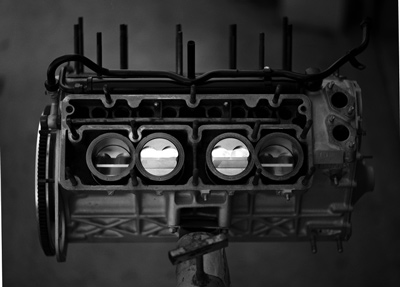
The 70 degree V8 featured an alloy block with wet liners, and a bore of 72mm. Adriaensens makes note of all the engine modifications from its inception as a proposed luxury car engine to an all out competiton powerplant. Photo TA, copyright CorsaResearch.
|
The brainchild of Fiat's Dante Giacosa, Fiat's postwar take on the V concept was interesting if not novel. A 70 degree V, between which were mounted two dual barrel Webers; the cam was mounted high in the alloy block, using short pushrods to actuate the valves. Most notable were the exhaust outlets, mounted at the outside top of each alloy head, rather than side mounted. Three main bearings were considered a rigid enough mount for the compact crankshaft. With a bore of 72mm and stroke of 61.3mm, the total displacement was 1996cc. In this form it produced about 110 hp at 6000 rpm.
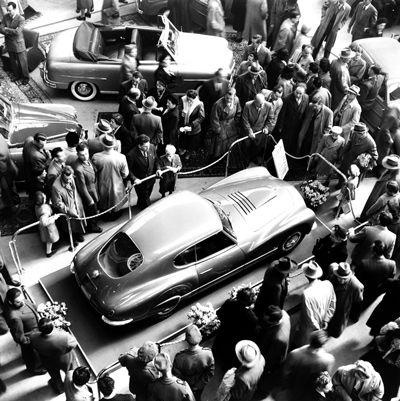
A grand introduction for the new Fiat Otto Vu 106 on March 20, 1952, at Geneva. Rapi's design is particularly attractive from this view. Photo by Silvio Durante, copyright Publifoto Torino/La Presse.
|
Initially designed to power a luxury sedan aimed at the U.S, the project was dropped, but the engineers decided to keep the V8 alive and, in secret, use it to power a new sports car. It was in this guise, at the Geneva show almost exactly 54 years ago on March 20th, 1952, that the Otto Vu engine was shown on a proud and eye-catching stand.
The story of this engine, the car itself, and it's successful racing history is written in two massive volumes by an unusually gifted and persevering young Belgian by the name of Tony Adriaensens, (read Tony's bio) already noted for his epic work on the Alfa Romeo GTA, ALLEGGERITA.
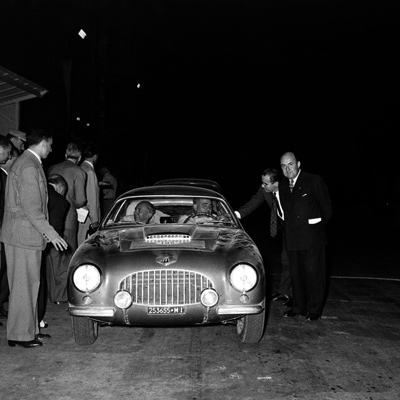
Another Zagato, this one 00060, here raced by Franco Cornacchia and Franco Cortese at the Giro Automobilistico d'Italia in 1954. Photo by Jean Sejnost, copyright CorsaResearch.
|
Did we say two volumes? Well, in addition to the Fiat-produced Otto Vu, of which 114 chassis were built and dressed by Fiat as well as Ghia, PininFarina, Vignale and Zagato, Siata implanted the Otto Vu into their own chassis, and the prolific Mr. Adriaensens created a second volume for the Otto Vu Siatas. We sent award-winning historian and Siata owner Carl Goodwin the Siata volume to review (next week in VeloceToday) while we tackled the Fiat Otto Vu, Volume 1, which alone accounts for 670 top quality paper pages. The set is delivered in its own handsome suitcase and weighs about 15lbs. Lift it with your knees and don't put it on the same shelf as Time and Two Seats.
And let us say, as Carl Goodwin will no doubt repeat, that together or separately (but they are only sold in a set), Adriaensens Otto Vu is a masterpiece, eight years in the making and finally rushed to press this year.
There are niggling negatives; the print is too faint and small for old eyes, the organization and grammar could have benefited from a good editor, there are a few typos, no index, and no bibliography or footnotes. The author is aware of these shortcomings, but realizes that after ten years in the making, it was time to publish or perish.
And publish he did, aided by his wife Nadine Van de Putte, who did a remarkable job with the layout, managing the huge number of stunning photographs to best effect. At last report they were still married!
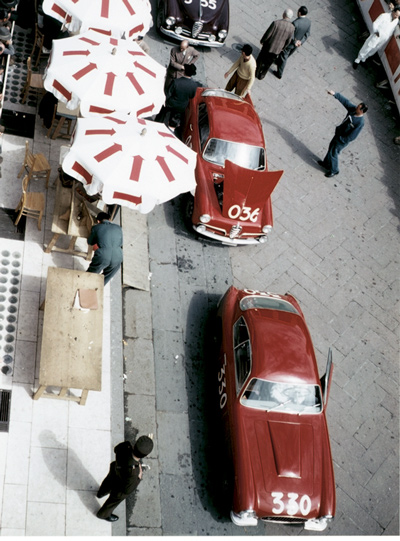
Bresica, 1956. The Otto Vu Zagato, chassis 00061, gets ready for the Mille Miglia. Adriaensens tracks the Zagato-bodied Otto Vus in detail. Photo by Marcus Chambers, copyright Ludvigsen Library.
|
Throughout the book, the photography is almost overwhelming--so much new, and even the prints used previously are reproduced with great care; if you've seen a few before, you've never seen them like this. Excellent original prints were scanned at 600 dpi, and printed at 300 dpi, more than twice the standard
rate, and the results are superb.
Lavish, yes, but the most important information in such a massive and expensive work must include the following:
Each car by serial number for easy reference.
Each car identified by photos.
The events in which each car participated.
Drivers, car numbers and final placings.
Past and current owners.
Significant changes to body and chassis.
Engine serial numbers.
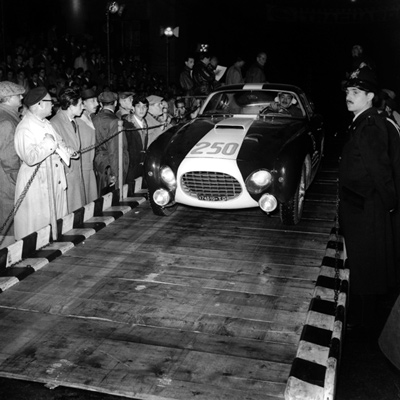
A dramatic Vignale bodied Otto Vu, chassis number 00052, on the ramp at the 1957 Giro d'Sicilia. A few months later the car appeared at an event in Turin with a much modified nose as the result of an accident. Photo copyright Publifoto Palermo.
|
All of the above information resides between the covers. There are a few cases when the answers simply aren't known, owners do not wish to be identified, and a few chassis numbers which lack a photo. This is to be expected, but it is minimal.
This Holy Grail comes well after lengthy and informative chapters on the development of the engine, chassis, body, technical data, early racing and owner's remembrances, chapters on each of the special body builders and a very detailed racing history. Adriaensens has not missed a beat. It is an absolute must-have if it can be budgeted.
As we said, Detroit was lord and master of the V8 engine. But in 1954, one of the Ghia bodied "Supersonics" ended up in the hands of a Mr. Henry S. Lauve, who, as it happens, was the Head of Interior Styling at GM. And Mr. Lauve experienced a very Fiat moment, when, after only 9000 kilometers, the engine virtually self destructed. He promptly wrote to Fiat, and Mr. Lauve did indeed get an answer (the letter is reproduced and attached to a page in the book). And a new engine to boot. But as Adriaensens, and Fiat pointed out, the Otto Vu was not meant to be sold to the public, and was intended to be bought and used (raced) by wealthy amateur race drivers. Furthermore, the Otto Vu was a very reliable and competitive engine and car, at least in Italian race events. Fiat and GM, it seems, have been 'managing a relationship' for many, many years.